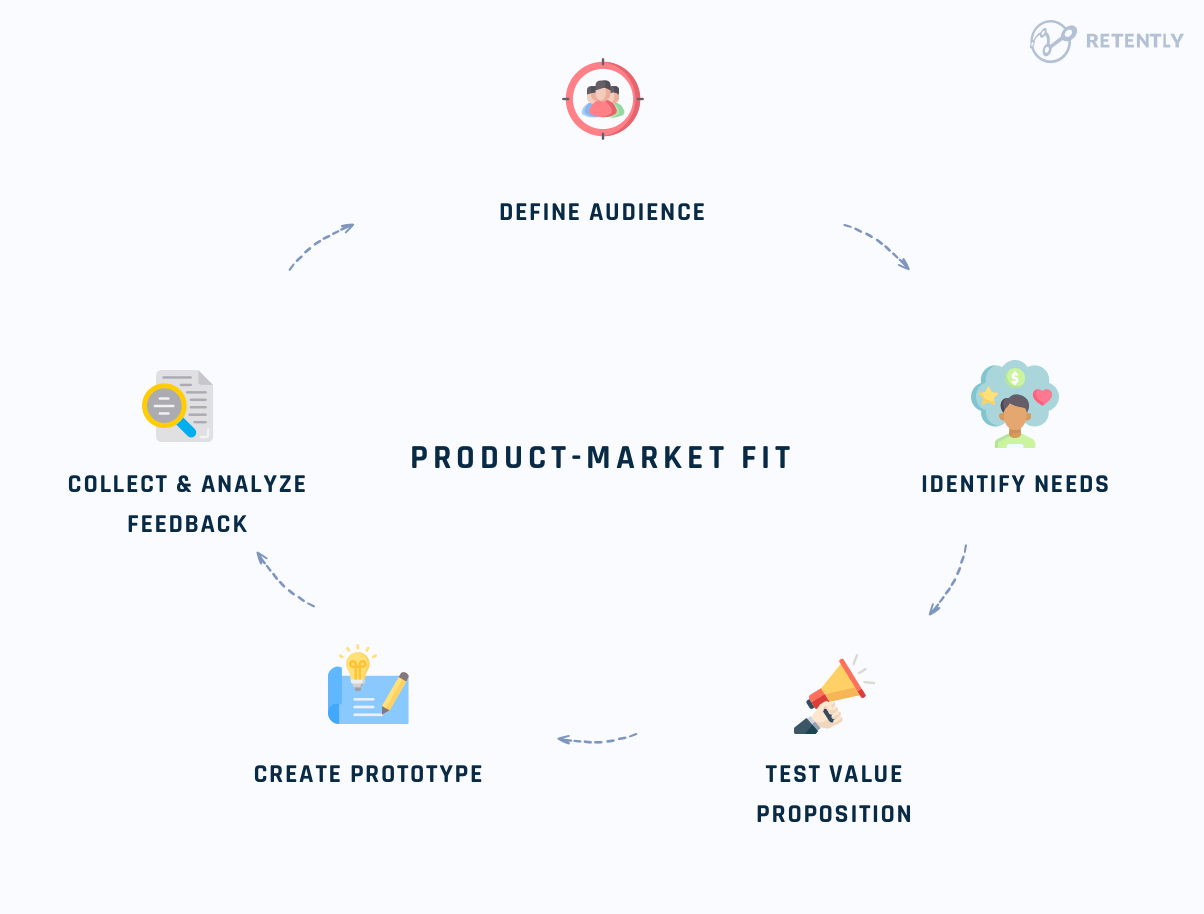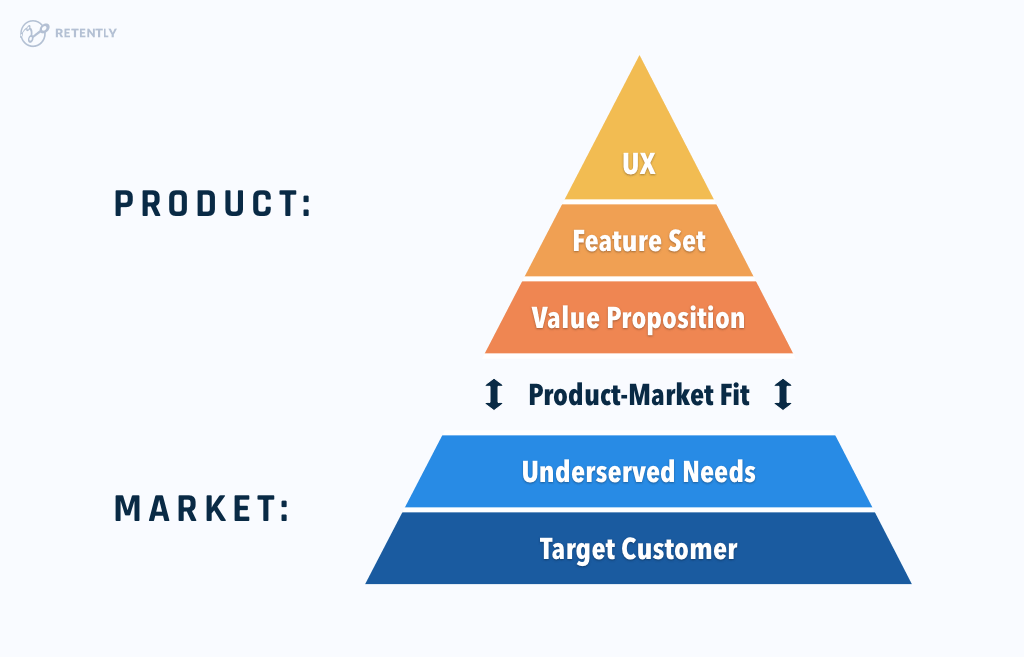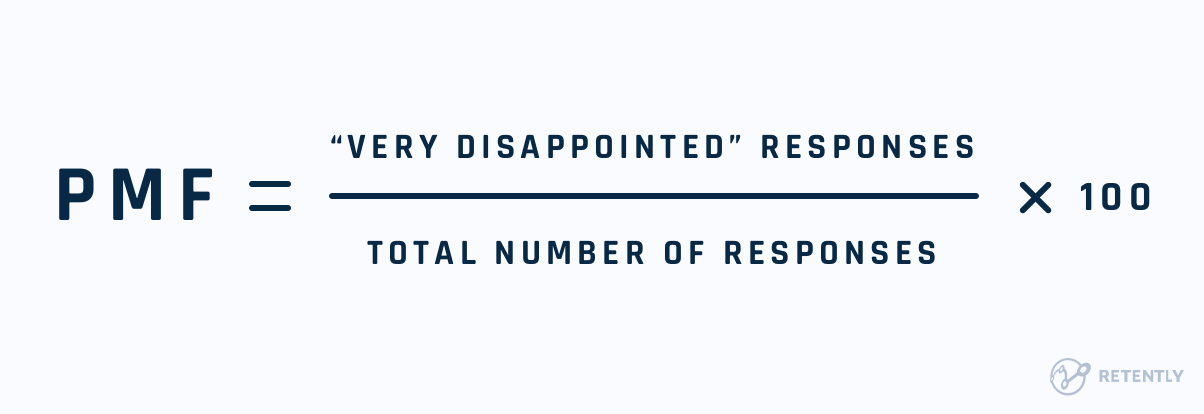Table of Contents
Achieving the much-desirable product-market fit is the ultimate goal of any SaaS business. After all, it means that a company has identified its business niche, has found a profitable market, and has a product that is well-liked by customers – the true Promoters. They don’t have to worry about going bust because what they sell is what the market needs.
Product-market fit (PMF) doesn’t happen overnight. It requires thorough research, analysis, planning, and time. And, as it was duly noted, if you have to ask yourself whether you achieved it, it’s most likely that you haven’t.
Before attempting to measure it, let’s first try to define what product-market fit is.
Key Takeaways
- Achieving product-market fit means your product resonates deeply with your target audience, leading to higher retention, customer satisfaction, and a foundation for scalable growth.
- The classic PMF survey question – “How would you feel if you could no longer use this product?” – is a powerful tool to measure customer dependency and uncover areas for improvement.
- If at least 40% of respondents say they would be “very disappointed” without your product, it’s a strong indicator that you’ve achieved product-market fit.
- PMF surveys go beyond the numbers – qualitative insights from open-ended questions help identify what users love, what’s missing, and what to fix to better meet their needs.
- Conduct PMF surveys at the right stage of your product lifecycle and ensure thoughtful survey design, targeting the right user segments to maximize the quality of insights.
What Is Product-Market Fit?
The term product-market fit is relatively recent, being coined by Marc Andreessen in 2007 in his guide for startups, “The only thing that matters”. The best definition was given by Marc Andreessen himself:
Product-market fit means being in a good market with a product that can satisfy that market.
In other words, to be successful, a business has to find a suitable market, define its needs and fulfill them with its products or services.
The market is the crucial factor here, though many would argue that a business starts with an idea, not with identifying a target audience. Actually, 35% of startups list “no market” as one of the top reasons for failure. Even if you have a great product, it doesn’t matter if no one needs it.
However, there may be a need in the market that the target audience is not yet aware of. But that’s until you demonstrate how your solution can benefit them. This way, you not only create a demand for your offering, but you are also directly addressing a previously unacknowledged need within your market niche.
Andreessen argues that it is easy to define whether a business achieved product-market fit. When the product is sold in large quantities, word-of-mouth works better than paid advertising, and when you can finally concentrate on growth instead of development, you know you’ve nailed it.
PMF behind the scenes
Let’s break it down with some examples:
- Slack: When Slack launched, it wasn’t just another communication tool. It nailed PMF by solving a real problem – making team communication faster, more organized, and dare we say, fun. Businesses flocked to it, and Slack grew into one of the most popular collaboration tools in the world.
- Airbnb: Airbnb’s early days were rough, but once they figured out how to connect travelers with affordable, unique stays while also helping hosts earn extra income, it was game over. They hit PMF, and the rest is history.
- Netflix: Remember when Netflix shifted from DVD rentals to streaming? They saw where the market was headed and built a product that perfectly matched customers’ desires for convenience and on-demand entertainment. The result? Industry leadership.
When you achieve PMF, your product doesn’t just fit into the market – it owns a space in your customers’ lives. That’s why PMF is so critical, especially for startups. It’s not just about having a great idea; it’s about creating something your audience truly values.
Why Is Product-Market Fit so Important?
Well, there are reasons beyond just steady high profits that come with achieving it.
The main advantage of adhering to the product-market fit strategy is that when building a product, the market for it is already there. Starting a business and knowing that an audience is ready to buy your product considerably eases sales and marketing efforts. Once achieved, it allows you to concentrate on growth and scale up operations. Without product-market fit, attempting to scale the business too early can lead to failure and wasted resources.
Product-market fit also allows companies to focus on the most promising market opportunities. When one has found the right market, it can devote its efforts to expanding in that market and developing new products that will appeal to the same audience.
Another reason why product-market fit is essential is that it helps to create a loyal customer base. When a product meets the target market’s needs, customers are likelier to become advocates for the product. That can increase brand awareness, which is vital for the long-term success of any business.
Last but not least, product-market fit helps understand customers better. Even if your product gets enthusiastic reviews from customers and niche media, it doesn’t mean that you are there yet. This happened to the Daily app launched by Buffer. Everyone seemed to love it, but it took the team some time to realize that people simply didn’t use it after the initial stage.
By analyzing the market consistently and gathering customer feedback, a company can stay informed about the needs of its target market and create a product that addresses those evolving needs in the long run.
Moreover, systematic market analysis and research will help identify whether the product still solves the problem and whether the market still needs it.
In short, PMF allows prioritizing tasks and concentrating efforts on the most critical aspects of your business at a specific stage of product development.
How to Achieve Product-Market Fit
While finding product-market fit isn’t easy, there are some actionable steps businesses should take at the early stages. Dan Olsen, the author of The Lean Product Playbook, developed these as a guide to achieving product-market fit. These steps focus on the audience and the product itself.

1. Define the target audience
The first step any business should take is defining its target audience. Start with creating the so-called persona, a perfect customer. Analyze their background, who they are, what they do, and what their typical work day looks like. Understand their interests and everyday struggles, and when you do, you can see whether your product is relevant.
2. Identify your audience’s needs
The next thing to do is identify the needs of your target audience, but not any needs. You have to find the pain points that existing options can’t adequately solve. Even if you created a great product, look at it from a customer’s perspective and try to understand whether it will deliver added value.
Analyzing competitors is crucial as it is most likely that your potential customers are now using their products/services to solve their issues.
3. Test your value proposition
Your value proposition is the benefits of your product and how it will solve your audience’s existing pain points. Make a list of features your product has and compare it to your competitors to determine whether you can outperform them. Identify unique ideas or improvements to differentiate yourself and offer a better solution.
4. Create a minimum viable product
A minimum viable product is the initial version of your product. It should have enough features for your customers to try and provide feedback on – used for further development. It’s the best way to find out whether customers will benefit from your product, and the cheapest – as there will be no need to invest big money in the project.
First, outline the minimum number of features that will satisfy your customers’ needs and create a prototype. It will most likely have bugs, but don’t let this stop you. Send this prototype to your target audience and ask for feedback. Collect and analyze the customer data, check whether they encountered similar issues, and use it to improve your end product.
5. Product-market fit pyramid
To structure the steps for achieving PMF, Dan Olsen came up with a 5-layer pyramid. He put the audience and its needs into the lower two levels and the product itself – into the top three layers.
The target customer is the foundation of the pyramid: this is the market you will sell your product to. It is followed by the needs your product should solve. Businesses can only analyze and research these two layers, as they do not have control over them.
The product comes next, featuring a value proposition that addresses customer needs and includes the necessary features; followed by the user experience where customers test/use your product.
It should be noted that if you skip any layer or don’t pay proper attention to all of them, the pyramid will collapse, and the desired product-market fit won’t be achieved.

Hence, before jumping into product development, it’s important to first identify and answer the key questions about the target market, customer needs, and potential demand for the product. By understanding these factors, you can make sure that you are building and launching a product that truly meets customer expectations and has a viable market.
How to Measure Product-Market Fit
There are many metrics you should consider as, in many cases, you will be measuring satisfaction and engagement levels. You should look into churn rates and changes in the CLV (Customer Lifetime Value), but sending surveys is the quickest and easiest way available to any business. So far, the Product Market Fit, or PMF survey designed by Sean Ellis, serves the purpose best. So, what is a product-market fit survey?
1. PMF survey example
While customer satisfaction surveys give you an idea about the customer’s attitude towards your product, it doesn’t really help with identifying how necessary that product is. Sean Ellis, an entrepreneur and investor, came up with a simple question to assess this need – which makes up the core of the product/market fit survey template.
It features the question: “How would you feel if you could no longer use our product?”. Respondents must choose from several alternatives: Very disappointed – Somewhat disappointed – Not disappointed (it really isn’t that useful) – N/A as I don’t use it anymore.

The PMF score is calculated by dividing the % of Promoters – customers who responded with “very disappointed” – by the total number of responses. Hence, if you have 40 Promoter responses and a total of 60 responses, your PMF score will be 60% (PMF score= 40 “very disappointed” responses/60 total responses * 100).

Ellis argues that if at least 40% of respondents would be very disappointed, then a company achieved product-market fit. Another requisite is sending the survey to customers who have used your product for some time and fully understand its features. And, it turns out that there is no need for big numbers to get to a result: in many cases, 40-50 responses are enough to get an idea about the need for a product.
2. Open-ended Product-Market Fit survey questions
As in the case of customer satisfaction surveys, by itself, this question alone isn’t enough. You can always follow up with open-ended questions allowing respondents to expand on the details behind their answers. In case they wouldn’t be disappointed, you could ask them whether it is because they found a better alternative (and which alternative) or they simply don’t need your product.
Still, there are three essential follow-up questions that must be addressed to get more relevant and actionable feedback, to be further used in development and growth strategies.
As one of the product-market fit conditions is finding the right target audience, why not ask your customers about it? They have used your product for some time and could give you additional insights and show you the right direction. Ask them what type of people would benefit most from using your service/product and create a persona based on the responses. Describe their job, everyday life, and duties, their potential problems and expectations – this will be your perfect customer – and build your product for them. Though it may seem that this approach narrows your audience too much, in practice, it is not.
It is now time to understand the strengths of your product. Ask your customers about the main benefit they get: speed, easy navigation, reliability, or customization options. Concentrate half of your efforts and time on improving that specific feature.
As customers know their needs better, ask them how you can improve your product. You will most likely receive multiple suggestions, but, you should carefully analyze them to ensure they suit your target audience. Instead of jumping into the creative fever and adding as many features as possible, narrow down the suggestions and choose the most relevant ones. This is where you should concentrate the other half of your efforts.
Rahul Vohra used this approach to help his company Superhuman reach product-market fit. He sent his clients a short survey that included the question from Sean Ellis and these three additional questions to gain new insights into the perfect customer and the features they value most.
By segmenting and analyzing responses, he improved the already existing beneficial features and created a product roadmap that included some of the most relevant customer suggestions. He then split the suggestions further into different categories depending on the cost and impact and concentrated his efforts on high-impact/low-cost options.
But the most important thing Rahul Vohra did was proper segmentation of customers. Instead of trying to understand why customers wouldn’t be disappointed if they could no longer use Superhuman, he analyzed the responses and suggestions of the other two groups and split them further based on the created persona. This exercise helped him get a better understanding of the product-market fit score and customer needs and concentrate his efforts on truly relevant features. Considering that their score went from 22% to 58% in three quarters, the approach works.
Is Finding Product-Market Fit Enough for Success?
Though the idea behind product-market fit seems easy to understand, not everyone is convinced: some entrepreneurs find faults in the system. Rand Fishkin, the founder of Sparktoro, is concerned that people who blindly follow the concept commit errors on their way.
For instance, he argues that switching from developing a product to scaling the business isn’t the best move as the product should keep evolving to correspond to customers’ demands. In addition, startups refuse to consider other aspects of making the product appealing, like pricing.
Another problem is that companies don’t optimize their marketing efforts before and after product-market fit and fail to build a client base. In search of investments, they work hard to achieve product-market fit, forgetting about other aspects.
Another concern is that there is no reliable way of finding whether product-market fit has been achieved, thus meaning that the consequent actions based on ‘feeling’ may harm a startup instead of helping it to prosper.
Fishkin suggests simultaneously working on product development and its promotion. If a startup has a small loyal client base, it is a good idea to search for similar customers, adjusting the product to suit their current and future needs. His idea is to split the customer base by size, brand awareness, and conversion and analyze it further to make the right decisions about when to develop the product and when and to whom to promote it.
Find Out if You’ve Achieved Product-Market Fit
Having the correct product available in the right market at the appropriate time is the essence of product-market fit. Though achieving it requires considering many factors, measuring it is simpler by analyzing customer behavior and running customer surveys. Only by understanding your users will you be able to optimize your product to turn it into a must-have, as well as adjust your marketing efforts for a better reach-out.
Actively engage with customers from the initial stages of developing a product idea. By gaining a clear perception of their needs and wants, you can create a value proposition that leverages the company’s unique strengths to create a meaningful competitive advantage.
PMF and NPS surveys are the most suitable engagement methods, as they clearly show customers’ attitudes toward your product or service. Retently offers the possibility to send these types of surveys by customizing templates, including the questions, and integrating with many online services like Salesforce, Zapier, Slack, Hubspot, etc. In addition, when signing up for an account with Retently, you will get a 7-day trial to make sure it meets your requirements before committing.



































 Christina Sol
Christina Sol 

 Greg Raileanu
Greg Raileanu 
 Alex Bitca
Alex Bitca 

